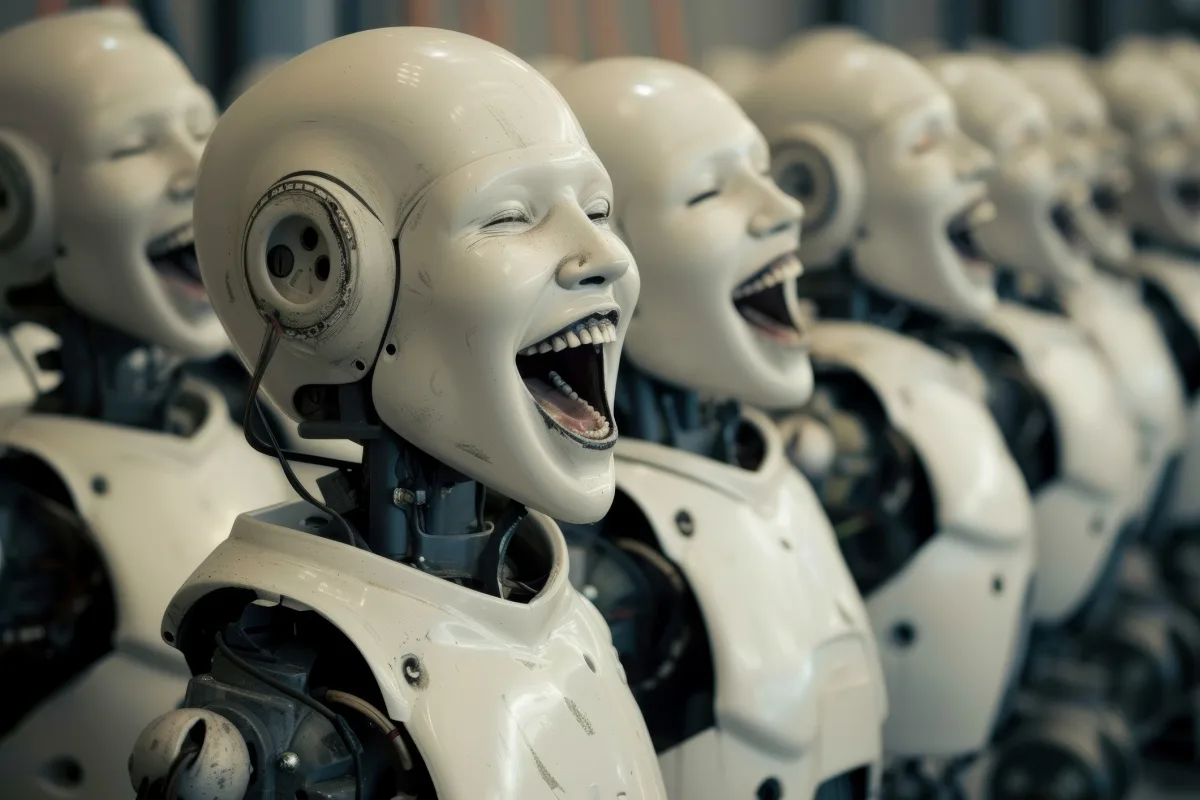AI and AI-controlled humanoid robots will, in all likelihood, transform our societies beyond recognition. Whether this technology will ultimately prove positive or negative for our civilisation remains an open—and existential—question.
Humanoid, AI-driven robots designed to help us in daily life are no longer science fiction but a technology already available. They will only become cheaper, more versatile, and more accessible in the years ahead. Before long, they will be visible everywhere in society. There are numerous estimates of how quickly, and in which sectors, this technology will first be adopted.
Conservative estimates predict that between 150,000 and 300,000 humanoid robots will be deployed by 2030, mainly for niche industrial uses, with numbers increasing steadily thereafter. The baseline scenario, supported by most analysts, projects annual shipments of between 180,000 and 250,000 units by 2030, leading to a total stock of several hundred thousand. The optimistic scenario, regarded by most observers as ambitious, foresees more than one million units by 2030.
Like all technologies, humanoid robots will rapidly improve and expand in purpose. From initially performing simple, repetitive tasks on factory floors and similar settings, they will gradually become more advanced and capable of executing increasingly complex operations. Virtually every profession will be affected: before long, domestic, repair, care, police, and military robots—among others—will become part of our everyday lives.
Since these are jobs currently done by humans, the consequences will be staggering—with profound economic and political implications—for our open democratic societies. In this context, one can roughly distinguish between three main scenarios—both economic and political—which at their extremes appear either utopian or dystopian.
Economic scenarios
In a perfect world, the rise of such robots would represent the ultimate economic good for our societies. By moving people out of relatively unproductive jobs into more productive ones, and by democratising access to professional expertise, everyone would benefit from the technology. Not only would it make people’s lives easier through higher economic growth and greater prosperity for all, but it would also reduce social and economic inequality. Most people would be able to realise themselves by pursuing meaningful occupations in the true Kantian spirit, and at the same time enjoy more leisure to live the good life.
There is also a less perfect scenario, though still acceptable to most, which would ultimately prove beneficial to society. In this case, humanoid robots and AI would take over almost all possible jobs, rendering the vast majority of humans redundant and pushing them out of the labour market, leading to mass unemployment. Such an outcome would be frightening, but not necessarily existential. If political and economic solutions such as wealth redistribution measures—for instance, universal basic income or similar schemes—are swiftly implemented, people could instead devote their lives to art, culture, and leisure.
However, there is also a scenario that is truly terrifying – one that poses an existential threat to social stability. Here, AI and humanoid robots would take over nearly all jobs, while economic policy fails to adapt and find solutions in time. In such a dystopian scenario, the vast majority of people would lose their livelihoods, with nothing to fall back on, leading to unknown and frightening consequences.
It is difficult to say which of these scenarios is most likely. In Norway and our neighbouring countries—wealthy, developed democracies whose political systems must respond to public preferences—scenarios one and two seem the most plausible. But scenario three—a dystopian techno-oligarchy where a microscopic elite controls nearly all wealth—is, unfortunately, not entirely unthinkable.
In the non-democratic parts of the world—where welfare systems are virtually non-existent and democratic accountability absent—scenario three, by contrast, appears far more likely. The absence of effective mechanisms for wealth redistribution, combined with an entrenched economic elite that has never had to consider the people, makes such an outcome entirely conceivable.
Political scenarios
While it is thought-provoking to imagine the economic scenarios that may result from the rise of AI-controlled robots in our societies—especially the worst possible outcome—these pale in comparison to the potential political consequences. Although the economic and political dimensions naturally overlap, and many scenarios go hand in hand, important differences remain.
Humanoid robots will undoubtedly be used for purposes involving the use of force and the state’s monopoly on it—not only for policing but also for military purposes. The real question will then be who—or what—ultimately controls them, and what that will mean for our societies. With the revelations about Norwegian electric buses from China that can be remotely controlled from Beijing still fresh in memory, the answer to this question could have unimaginable consequences—not only for our civilisation but for humanity itself.
In an ideal world, these humanoid robots would ultimately remain under the control of democratically elected governments, accountable to their own people. They could then play a positive role within the alliance of democratic states. Under proper democratic oversight, they could significantly strengthen law enforcement and defense forces by making them more precise and effective—allowing us to stand stronger against our rivals. Most importantly, they could be activated and deactivated whenever the authorities deem it necessary.
A more troubling scenario is that control over these robots ends up in the hands of a small group of individuals who use the immense power this entails to take control of our societies. It is not difficult to imagine this power being concentrated among a handful of private actors who would use it to dismantle democracy and establish a dystopian techno-oligarchy.
The final scenario—the most alarming and dystopian of all—is that these robots ultimately fall under the control of a self-aware artificial superintelligence (AGI) seeking to rule the world. Given that AGI is predicted to be up to a million times smarter than humans, it seems naïve to believe we could stop such an outcome if our coming silicon overlord were to desire world domination.
These robots could then become the foot soldiers of such a consciousness, enforcing its rule over the planet. And it is not inconceivable that, from the perspective of such an intelligence, humanity would need to be subdued—or even eradicated altogether—to protect the world from the destructive force we represent. This may sound absurd, but it would be madness to rule it out entirely.
Into uncharted waters
These economic and political scenarios are, of course, far from exhaustive, and this analysis merely scratches the surface of the challenges ahead. One can easily imagine a number of other outcomes—especially concerning how the emergence of autonomous humanoid robots might affect the dynamics of autocratic societies, since this discussion primarily considers democratic systems.
But regardless of how one evaluates the strength of the arguments above, one thing seems indisputable: the world is facing the most system-altering transformation in human history. And there is no turning back if our civilisation and our democratic systems are to remain competitive and relevant in the face of the Fourth Industrial Revolution.
In today’s global geopolitical landscape—where realpolitik zero-sum games have replaced win-win cooperation—all means are now employed to acquire power and control strategic pressure points, which in turn are used to gain influence over others. As the ultimate technology that governs all others, states that fail to embrace AI and AI-driven humanoid robots will be unable to keep up with development—and will thus be condemned to history’s scrapyard.
Who ultimately controls the technology, and how it is applied and deployed, will define the balance of power between democratic states and their authoritarian counterparts for generations to come. The outcome will likely determine the path humanity ultimately takes. Either it will tip the balance in favor of democracy—for freedom, human dignity, and prosperity, to the benefit of humankind and ordinary people—or it will serve as a tool of oppression to cement autocratic regimes across the globe. It could also lead to the creation of an entirely new form of governance—or, in essence, a real-life Matrix.
Stronger together
The stakes have never been higher for humanity. All political capital must therefore be mobilised to ensure that the rise of AI-controlled humanoid robots becomes a force for good—benefiting our open societies and, ultimately, humankind itself. We have no time to waste. Norway and Europe, which do not control the technology but have the most to lose, must stand at the forefront.
After outlining these far-reaching possible outcomes, the decisive question remains: How can we, in practice, steer this development in a direction that benefits humanity rather than undermines it? It is difficult to imagine the best path forward, but one thing is certain: the technology carries an unavoidable geostrategic dimension and will undoubtedly be used as a realpolitik weapon in the global struggle for power.
It is therefore in the collective interest of the democratic world that control over the most advanced AI technology ultimately remains in the hands of democratic states. They must stand together. The United States is clearly dominant and firmly in the driver’s seat, but it also has a vested interest in rallying as many allied nations as possible to support it in developing the most optimal solutions.
One possible path forward would be to establish a transnational commission composed of experts from industry, academia, and the public sector in like-minded democracies, where these challenges could be discussed in detail to best prepare us for what lies ahead. Thereafter, we must simply ‘cross the river by feeling the stones’, as a wise Chinese man once said. But we must take care not to fall.
Photo: Dreamstime.






